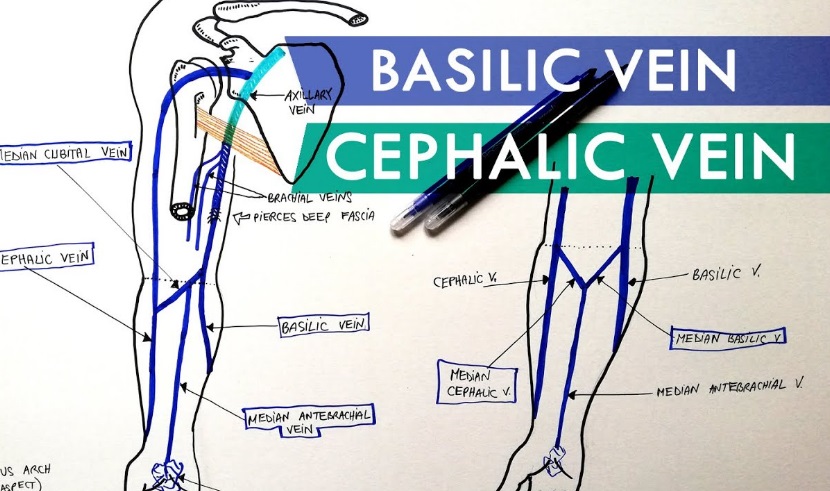The basilic vein runs from the center of the hand and up your arm on the ulna (a long bone that stretches out from your elbow to your finger) and the finger. The basilic vein is shallow since it’s close to the outer layer of your skin. It’s not an unexpected appearance on the inner arm.
This vein’s responsibility is to carry blood from the hand and arm back into the heart. The device can be used for different operations, including vein punctures and transfusions.

Table of Contents
Drainage and course
The basilic vein runs down the ulnar side of the arm and helps in depleting the dorsal venous organization of the hand. It is more limited than the cephalic vein and ends once it joins the brachial vein close to the elbow. The basilic vein punctures the thick sash at the elbow and joins the venue committee of the brachial vein to frame the axillary vein.
The basilic vein channels into the brachial vein (part of the profound venous framework), which then, at that point, channels into the axillary vein once it crosses the mediocre line of teres major. The axillary vein currently joins the cephalic vein (part of the shallow venous framework), and when this enormous vein crosses the parallel boundary of the main rib, it renaim subclavian (under the clavicle) vein
The veins of this framework hold valves inside their lumen, which allow them to reverse. They are more prevalent in the deep veins, even though they do exist in shallow veins. They found where the veins anastomose.
Tributaries
The shallow veins of the upper appendage are extremely prominent and have numerous shallow feeders which channel into them. Two such factor feeders of the basilic vein include:
- the middle cubital vein
- interfaces the basilic vein to the cephalic vein in the foremost part of the cubital fossa
- it is a typical site for venipuncture
- the middle antebrachial vein
- emerges from the palmar venous plexus on the center of the hand, which depletes the palmar advanced veins. It courses anteriorly in the lower arm and depletes the subcutaneous tissue of the wrist and arm
- it ends in the basilic or middle cubital veins
- now and again the middle antebrachial vein separates into middle cephalic and middle basilic veins at the elbow, which then, at that point, channel into the cephalic and basilic veins individually
Physical Variations
Human life structures follow certain “standard” structures, but not everyone is the same. Varieties in the ways of the veins do happen. Medical care providers should know about what complications they might experience, particularly during surgeries or while embedding a needle into your vein.
Studies have revealed two normal varieties of the basilic vein, the two of which have to do with the brachial veins where they join the basilic. There are also varieties of different veins associated with these ones. Certain individuals might have a variety in one arm but not the other.
The function of the basilic vein
The basilic vein can empty the blood of parts of your hand and arm so it can return to the heart and lungs to be oxygenated and siphoned out once more.
The dorsal venous organization of the hand empties the blood of the center of your hand and sends it vertically to the basilic vein. Small parts of the basilic vein transport blood from both arms. All of that moves to the axillary vein over where the basilic and brachial veins meet up.
Clinical Significance
The basilic vein and other shallow veins of the arms used in operations, for example,
- Vein cut for regulating intravenous medications or taking blood tests
- Bindings of medicine or blood
- Sidestep unite, which includes taking a piece of the vein to fix another vein that is harmed or sick
- The favored site for these methods is within your elbow due to its ease of access to the veins. In addition, it moderately protects in comparison to other regions. There are shallow veins snaking through there which are clear indicators of this.
- Notwithstanding, among those veins, the basilic vein is the most significant.
- Average cubital vein, which runs up the focal point of your inward arm and is normally exceptionally noticeable
- Cephalic vein, which runs up the thumb side of your internal arm and is more enthusiastically to see yet farther from other significant designs
The basilic vein is trickier to get to because it’s nearer to the brachial course and the middle nerve, which makes it almost certain that a cut will prompt a physical issue of one of those structures.2 likewise, the middle cubital and cephalic veins are more steady, which means they’re less ready to move and roll away from the needle.
FAQs
The median benchmark width of the basilic veins was 5.1 mm (± SD 1.3 mm).
In some patients, this vein may not be well-positioned for venipuncture, particularly in the antecubital region. The syringe draw should be considered as the basilic vein is on the underside of the antecubital region. Secured and will roll, making it harder to manipulate a moving vein.
Shallow veins: The basilic and cephalic veins, which are shallow, connect to the axillary vein, however, numerous anatomic variations exist. After passing the external edge of the main rib, the axillary vein continues as the subclavian vein.
The basilic vein is liable for taking blood that doesn’t have oxygen from the arms back to the heart and lungs, where it’s given oxygen once more. While you can as a rule see it plainly, it’s viewed if all else fails in operations
